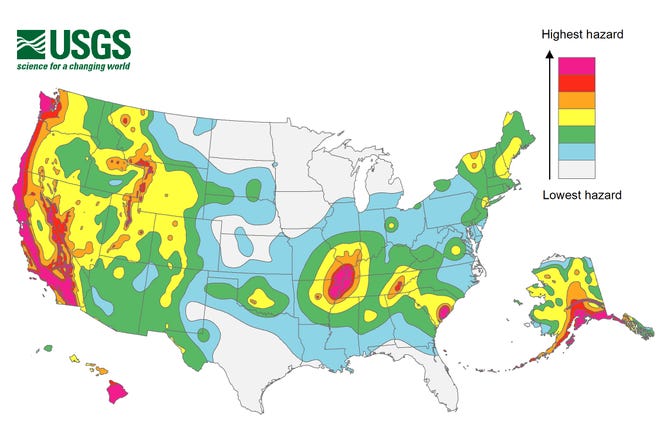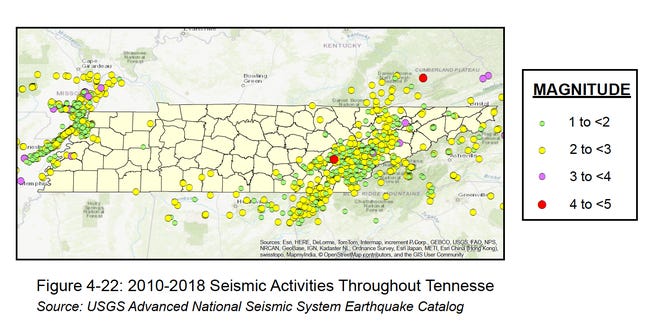Earthquake Challenge
How do earthquakes happen?
 How can we build an earth quake resistant buildings that is secure and cost effective base on the region of the United States?
How can we build an earth quake resistant buildings that is secure and cost effective base on the region of the United States?
As far as earthquakes go, East Tennessee is on shaky ground.
Since March of 2019 alone in East Tennessee, earthquakes of at least a 2.2 magnitude have rattled Mascot (2.4 on May 15), Coalfield (2.5 on May 10), Farragut (2.6 on May 8), Maryville (a 2.4 on April 4 and a 2.3 on March 18) ,Greenback (2.3 and 2.2, both on March 15) and Maynardville (3.4 on March 5).
The region experiences more seismic activity than just about anywhere else in the eastern United States, though a December 2018 4.4 magnitude quake near Decatur was atypically intense for the area.
The last East Tennessee earthquake that was more intense happened on Oct. 30, 1973, when a 4.7-magnitude quake rocked Maryville. On March 28, 1913, an even stronger quake struck Knoxville with an estimated magnitude of up to 5.9.
In 2014, the USGS increased the earthquake hazard potential of the area, rating parts of East Tennessee at the second-highest level of risk (on a scale from 1 to 7) – including much of Blount, Knox, Loudon and Monroe counties.
The only other regions east of the Rockies with that much hazard potential are in the South Carolina Seismic Zone (limited to South Carolina's central coastal area) and the New Madrid Seismic Zone (which includes much of West Tennessee as well as smaller areas of Missouri, Arkansas, Kentucky and Illinois).
John Bellini, a geophysicist with USGS, said “there is a history of earthquakes” in the Eastern Tennessee Seismic Zone, which extends into northwest Georgia and northeast Alabama.
The only other regions east of the Rockies with that much hazard potential are in the South Carolina Seismic Zone (limited to South Carolina's central coastal area) and the New Madrid Seismic Zone (which includes much of West Tennessee as well as smaller areas of Missouri, Arkansas, Kentucky and Illinois).
John Bellini, a geophysicist with USGS, said “there is a history of earthquakes” in the Eastern Tennessee Seismic Zone, which extends into northwest Georgia and northeast Alabama.
He said the Decatur-area quake, which was felt as far away as Atlanta, and the 3.0-magnitude aftershock that followed were among some 140 “measurable” quakes (with a 2.5 magnitude or higher) in East Tennessee since the mid-1970s.
Bellini said that the December earthquake was “unlikely to be the bearer of something larger,” though he added, “I wouldn’t be surprised to see a few more (aftershocks) over the next few days” as a result of settling.
In the unlikely event an even larger related earthquake occurs, December's quake would be revised to a “foreshock,” he said.
The epicenter of the 4.4 magnitude quake was some six miles northeast of Decatur and happened at 4:14 a.m. when “a fault stored enough energy that the rock cracked or ruptured,” Bellini said.
No significant damage has been associated with the quake, and Bellini said it would take something in the upper-4-to-5 magnitude range to impact structures. The most vulnerable buildings would be older structures such as houses with brick-and-cement chimneys, Bellini said.
Although earthquakes are common in East Tennessee, Bellini noted that the region is far less susceptible to major quakes than California and Alaska, the latter of which suffered a 7.0-magnitude quake near Anchorage on Nov. 30.
Anything with a magnitude of 7.0 or higher is labeled a “major earthquake,” with serious damage a likely result.
Smaller earthquakes usually only last a few seconds, Bellini said, whereas the major quakes can usually last from 10-30 seconds.
He said that even though it’s unlikely the quake will lead to something stronger, it’s always best to be prepared.
If you feel a quake, “get near or under a small piece of furniture such as a desk or strong table,” Bellini said. Or if possible, get into a doorway or a corner of a building, which tend to be the sturdiest parts of a structure.
Bellini said that there’s generally not enough time to flee a building during an earthquake, and the USGS doesn’t recommend that strategy anyway, because most injuries from earthquakes come from falling debris, including what falls off the outside of buildings. What's more, panicked running increases the likelihood of injury.
Tennessee Earthquake 3.0 Alsaka Earthquake 7.0
40 years of Earthquakes in the US 20 years of earthquakes in California 5 years of earthquakes in Alsaka
8 years of earthquakes in TN
How we design building to be earthquake proof
Your Challenge
How can you design and build a 3 story structure that will survive a mild "earthquake" simulation?
-
You will work in teams to design, create and improve a structure that will withstand a milk earthquake that are often seen in Tennessee.
-
We are looking for a cost effective design, less materials used will make a more cost effective desgin.
-
You will only have the supplies you are given.
-
your structure must have 3 levels of cardstock and they must be of the same size.
-
Materials

-
1 can of playdough
-
one roll of tape
-
3 cardstock sheets
-
10 toothpicks
-
4 straws
-
5 craft sticks
-
-
Step One
Read over the Constraints of the Earthquake Challenge
Step Two
Design your ideal structure based on the supplies you will receive. Use Earthquake challenge paper to record your anwers for Imagine and Plan. ( Partners will be asigned on build day)
Build Day
on Build day you will be assigned a partner and have 30 minutes to:
- decide on a final design
- begin building
- test your structure on the earthquake station
The last 15 minutes will be final test to see whose building is most stable AND clean up.

